How to Fluff a Pillow
To fluff a pillow effectively, start by grasping opposite corners and vigorously shaking it to redistribute the filling. Next, use the accordion method by compressing and releasing the pillow multiple times, allowing air to circulate through the material. You can also try manual kneading to break up any clumps, or place your pillow in the dryer with a tennis ball (wrapped in a clean sock) for 10-15 minutes on low heat. For natural rejuvenation, expose your pillow to direct sunlight for 3-4 hours, which eliminates bacteria and reduces moisture. These techniques vary in effectiveness depending on your pillow type, and there's much more to maintaining peak pillow performance.
This post may contain affiliate links. If you make a purchase through these links, I may earn a commission at no additional cost to you. Additionally, portions of this post may be generated using artificial intelligence (AI) technology. While we strive for accuracy, please be aware that AI-generated content may not always be perfect and should be fact-checked when necessary.
The Spatula Scoops
- Grasp opposite ends of the pillow and shake vigorously for 30 seconds to redistribute filling and restore loft.
- Clap diagonal corners together repeatedly to break up clumped filling and ensure even distribution throughout the pillow.
- Place pillows in the dryer with tennis balls on low heat for 10-20 minutes to restore fluffiness.
- Use the accordion method by compressing and releasing the pillow multiple times to introduce fresh air into the filling.
- Set pillows in direct sunlight for 3-4 hours to eliminate moisture, kill bacteria, and naturally restore shape.
Why Pillows Need Regular Fluffing
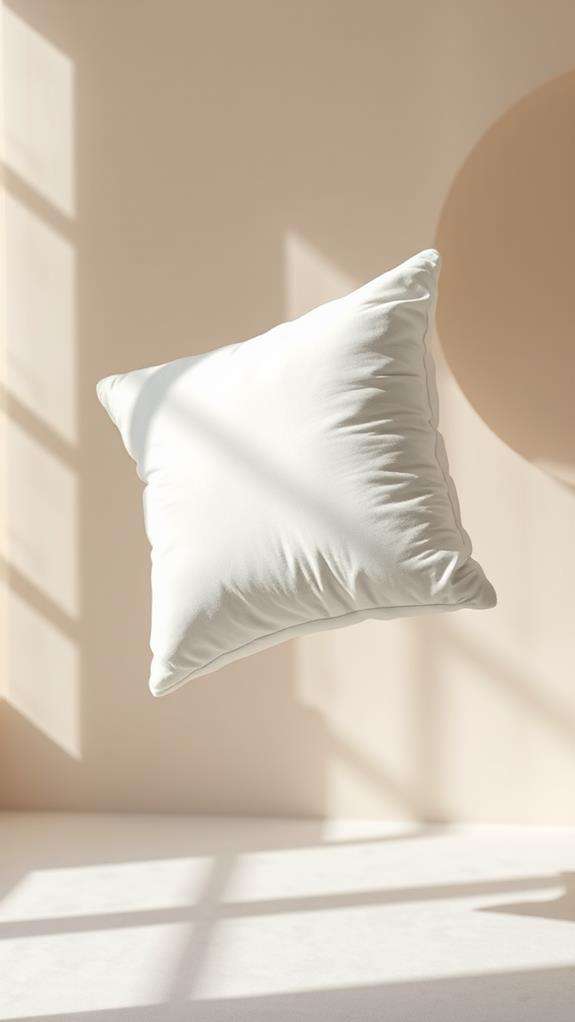
Throughout daily use, your pillows face constant compression that can profoundly impact their performance and comfort. When you rest your head on a pillow night after night, it accumulates moisture, dirt, and dead skin cells while gradually losing its original shape and support capabilities. This natural wear and tear process can considerably affect your sleep quality if left unaddressed.
Regular fluffing isn't just about aesthetics; it's a vital maintenance practice that helps maintain your pillow's structural integrity and functionality. When you don't fluff your pillows consistently, they'll become permanently compressed, leading to inadequate neck and head support during sleep. This poor support can result in spinal misalignment, causing you to wake up with uncomfortable neck and shoulder pain.
The Hand Fluffing Method
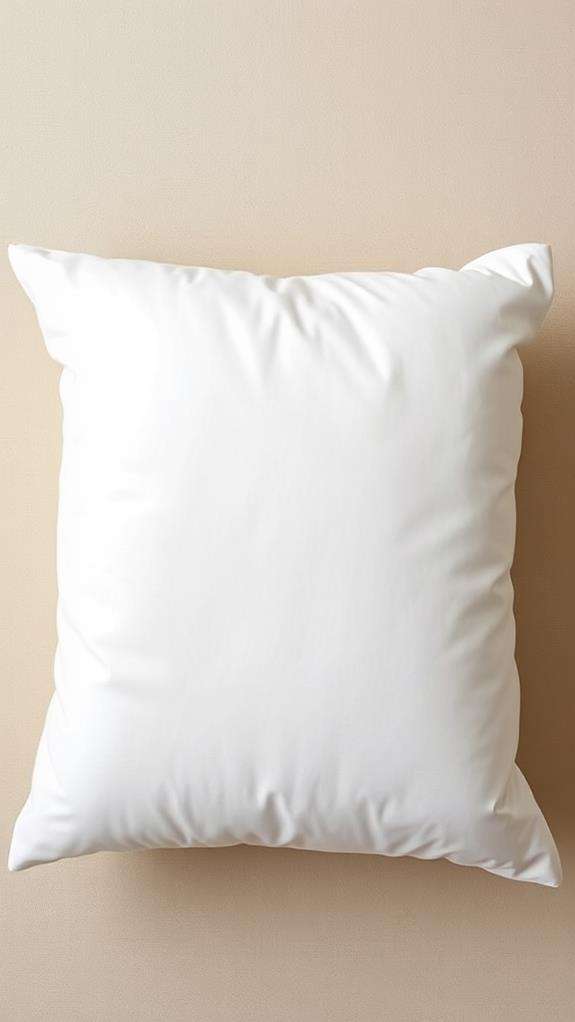
The hand-fluffing technique stands as the most straightforward way to restore your pillow's shape and comfort. When you're ready to revitalize your pillow, start by grasping one end and giving it a vigorous shake to jumpstart the reinflation process.
Next, you'll want to focus on the diagonal corners of your pillow, clapping them together to help redistribute the filling evenly throughout the entire surface. This motion helps prevent stuffing from becoming concentrated in specific areas. Follow this by using the accordion method, where you'll hold opposite sides of the pillow and create a compression-expansion motion that circulates air through the filling.
For any stubborn lumpy areas you encounter, employ a gentle kneading motion with your fingers. This massage-like technique effectively breaks up any clumps that have formed in the stuffing, restoring your pillow's smooth consistency. To guarantee ideal results, you'll want to dedicate at least 30 seconds to the entire fluffing process. Remember, consistent hand fluffing not only extends your pillow's lifespan but also maintains its supportive properties for a better night's sleep.
Dryer Techniques for Perfect Pillows
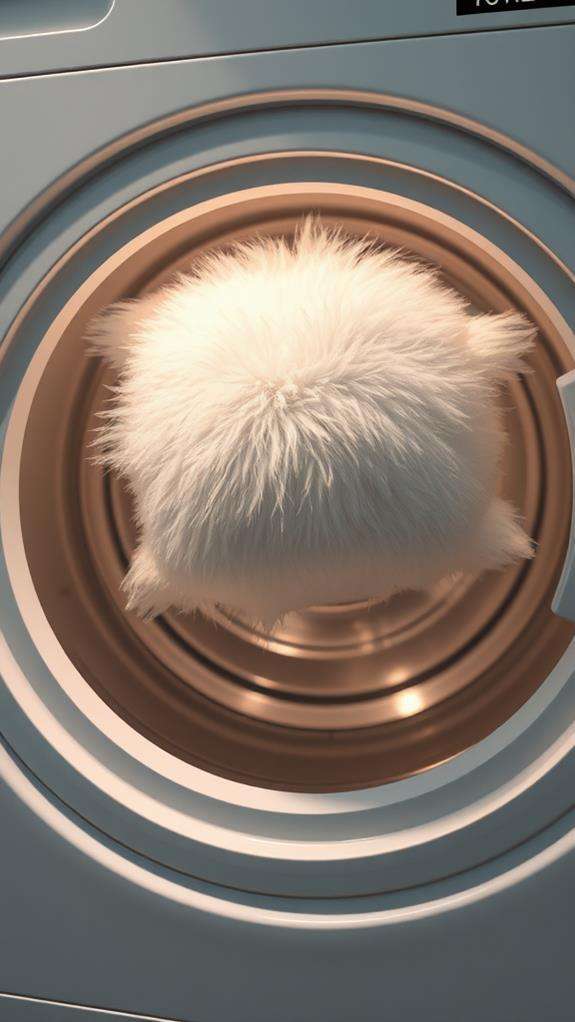
When you're ready to fluff your pillows in the dryer, you'll get the best results by setting the temperature to low or medium heat, which prevents damage while effectively restoring the pillow's shape. Adding a tennis ball wrapped in a clean sock creates the perfect amount of gentle agitation, helping break up clumps and redistribute the filling throughout your pillow. The key to success lies in running the dryer for 10-20 minutes while periodically checking your pillows' progress, ensuring they maintain their shape and achieve that cloud-like softness you're looking for.
Tennis Ball Fluffing Method
Reviving flat, lifeless pillows is remarkably simple with the tennis ball fluffing method. To fluff a pillow effectively, you'll need a clean tennis ball, a sock, and your dryer. Start by placing the tennis ball inside the sock, which prevents any marks or debris from transferring to your pillows during the process.
When fluffing your pillows, set your dryer to a low heat setting for 10 to 20 minutes. The tennis ball acts as a natural agitator, helping to redistribute the fill while breaking up any stubborn clumps that have formed inside. For best results, place two pillows in the dryer simultaneously to balance the load and enhance the fluffing action. The gentle bouncing motion helps guarantee your pillows get dry stuffed evenly throughout.
Before beginning this pillow care routine, always check the manufacturer's label to confirm your pillows are dryer-safe. This method works particularly well with synthetic-filled pillows, though it's suitable for various pillow types. If you notice your pillows aren't completely fluffed after the first cycle, you can repeat the process, ensuring they remain on a low or medium heat setting to protect the filling.
Heat Settings Matter Most
Building on the tennis ball method, selecting the right heat setting for your dryer stands out as a make-or-break factor in pillow fluffing success. When you're fluffing your pillow in the dryer, it's vital to check the care label first, as using incorrect heat settings can permanently damage your pillow's fill material.
For best results when trying to restore your pillow, set your dryer to medium to low heat and run it for 10-20 minutes. You'll want to enhance the fluffing process by adding dryer balls or tennis balls in socks, which help maintain the pillow's shape while distributing the fill evenly. Remember, high heat is your pillow's enemy, as it can melt synthetic materials and create inconsistent support throughout your pillow.
Don't rush the pillow care process – verify your pillow is completely dry before removing it from the dryer. Any remaining moisture can lead to unwanted clumping and potentially harmful mildew growth. By following these precise heat setting guidelines and being patient with the drying process, you'll greatly extend your pillow's life while maintaining its best fluffiness and support.
Sunlight and Fresh Air Benefits
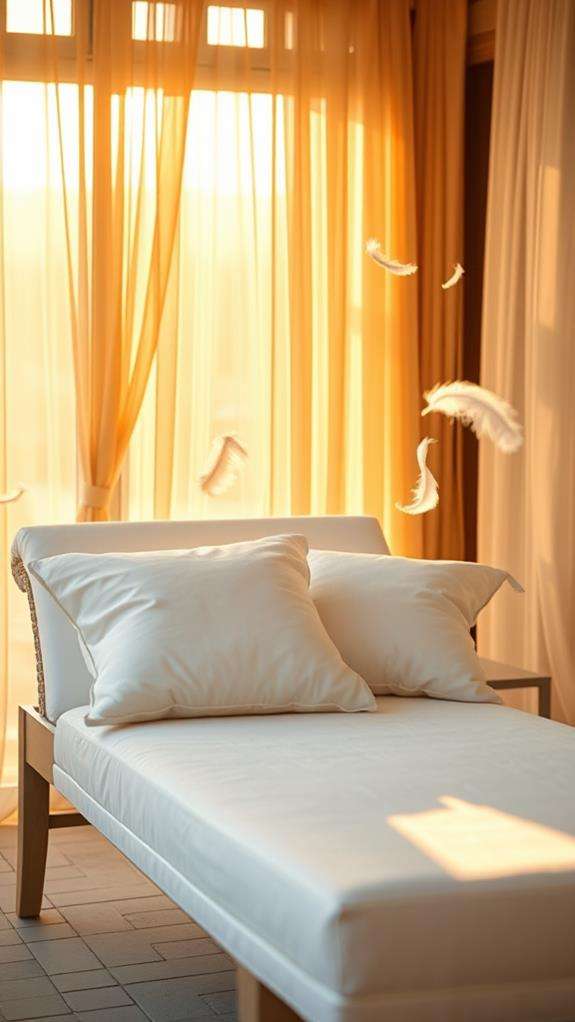
One of nature's best pillow-fluffing tools lies right outside your window. When you place your pillows in direct sunlight, you'll harness the power of ultraviolet light to naturally eliminate bacteria while improving their overall hygiene. The sun's warming effects, combined with fresh air exposure, create ideal conditions for rejuvenating your pillows' filling material.
To maximize these benefits, you'll want to set your pillows outside for 3-4 hours on a clean surface, such as a spotless table or fresh sheet. During this time, the sun's rays will work to restore your pillow's loft while fresh air circulation helps dissipate trapped moisture and unwanted odors that have built up from regular use. The natural warmth penetrates deep into the filling, encouraging it to expand and regain its original, comfortable shape.
You'll find this method particularly effective because it addresses multiple fluffing needs simultaneously: sanitization through UV exposure, moisture reduction through air circulation, and natural expansion through solar heat. When you bring your pillows back inside, they'll feel remarkably fresher and maintain better loft for your next night's sleep.
Different Pillow Types and Care
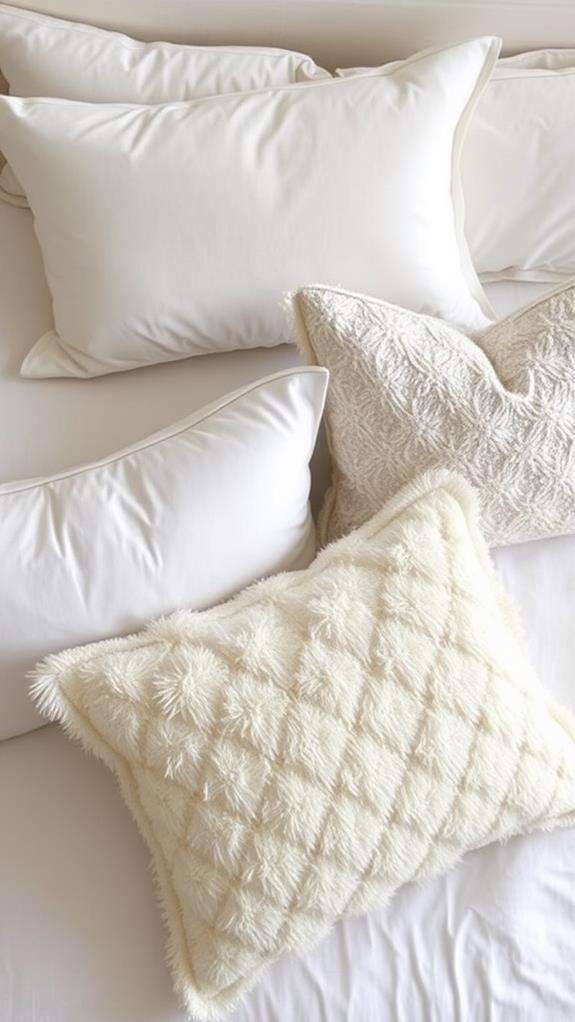
Your pillow's fill material directly affects how you'll need to maintain its shape and comfort, with options ranging from traditional down and feather to modern memory foam and synthetic alternatives. Bamboo pillows, for instance, benefit from regular washing every 3-4 months to enhance hygiene and restore their support (washing instructions for bamboo pillows). When it comes to care techniques, you'll find that down and feather pillows respond well to manual fluffing and quick dryer cycles, while memory foam requires gentler handling and occasional low-heat drying with tennis balls. Synthetic fills offer a middle ground, maintaining their shape through regular hand fluffing but occasionally needing dryer refreshers to prevent clumping and restore their original loft.
Popular Pillow Fill Materials
Different pillow materials require varying levels of care and fluffing techniques to maintain their shape and comfort. Each fill material has unique properties that affect how you'll need to care for your pillow to guarantee it provides ideal support throughout its lifespan.
- Memory foam pillows contour to your body but need low-heat drying and dryer balls to prevent clumping and maintain loft
- Down and feather pillows offer luxurious softness but require frequent fluffing to combat natural flattening
- Synthetic fill pillows resist flattening better than down but still benefit from regular fluffing and low-heat drying
- Latex pillows maintain their shape with minimal maintenance, making them ideal for those who prefer less upkeep
- Buckwheat pillows allow for customizable support through hull redistribution but need careful handling when adjusting
You'll find that some materials, like down and synthetic fills, respond well to daily fluffing, while others, such as latex and memory foam, need less frequent attention. Understanding your pillow's fill material helps you determine the most effective maintenance routine. For example, down and feather pillows benefit from daily fluffing to redistribute natural oils, while memory foam typically requires monthly rejuvenation through proper drying techniques.
Maintenance By Pillow Type
Now that you understand the various fill materials, let's focus on specific maintenance techniques for each pillow type. Each material requires different care methods to maintain peak comfort and longevity.
Down and feather pillows need regular attention, as they'll flatten with use. You'll want to fluff your pillows daily using hand fluffing techniques, and you can revitalize them in the dryer on low heat. For memory foam pillows, you don't need to fluff as frequently, but when you do, use dryer balls or tennis balls on a low-heat setting to help break up the foam and maintain shape. If you've got polyester fiberfill pillows, they require hand fluffing for at least 30 seconds to prevent clumping, plus occasional machine washing to maintain their loft. Latex pillows are low-maintenance and resist flattening, though you should air them out regularly to keep them fresh. For body pillows, use the accordion method – grab both ends and push them together, then pull apart – to restore their shape and check for lumps. Remember to distribute the fill evenly during this process for consistent support.
Signs of Worn Out Pillows
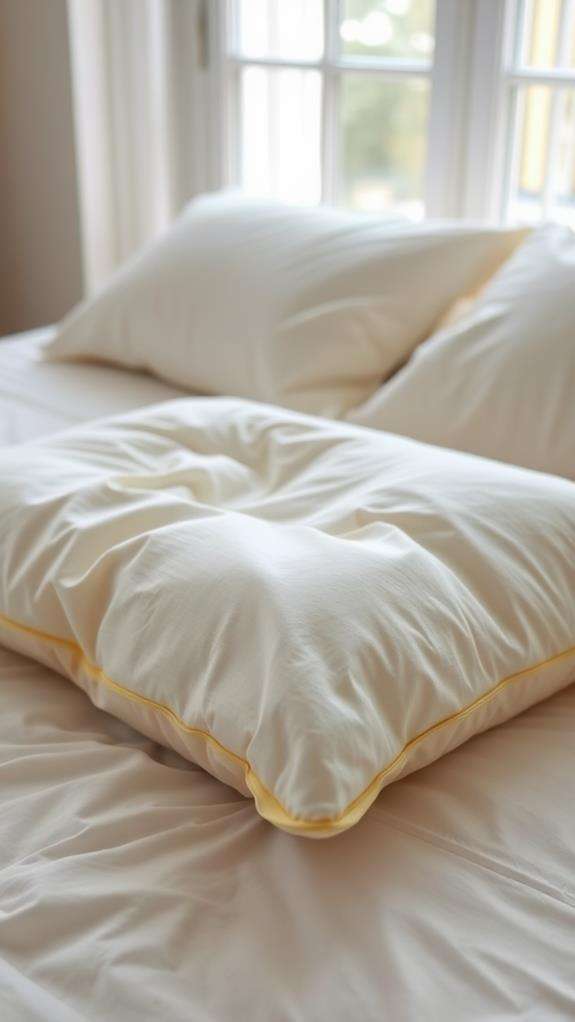
Knowing when to replace your pillows can save you from restless nights and unnecessary discomfort. Your pillow's condition directly impacts your sleep quality, and recognizing the signs of wear can help you determine when it's time for a replacement. If you're experiencing neck or shoulder pain after sleeping, your pillow may no longer provide the support you need for better sleep.
Here are the key indicators that your pillow needs replacement:
- When your flat pillow fails the fold test and doesn't spring back to its original shape, the filling has likely compressed beyond recovery
- Noticeable yellowing or discoloration of the pillow surface, which indicates buildup of oils, sweat, and dust
- Increased allergy symptoms while sleeping, suggesting accumulation of dust mites and allergens
- Persistent neck or shoulder pain that wasn't present when the pillow was new
- Development of lumpy pillows that don't respond to fluffing attempts
Don't wait until these signs become severe before taking action. Regular assessment of your pillow's condition can prevent sleep-related discomfort and maintain proper hygiene. Remember that a worn-out pillow can greatly impact your sleep quality and overall well-being.
Best Tools for Pillow Maintenance
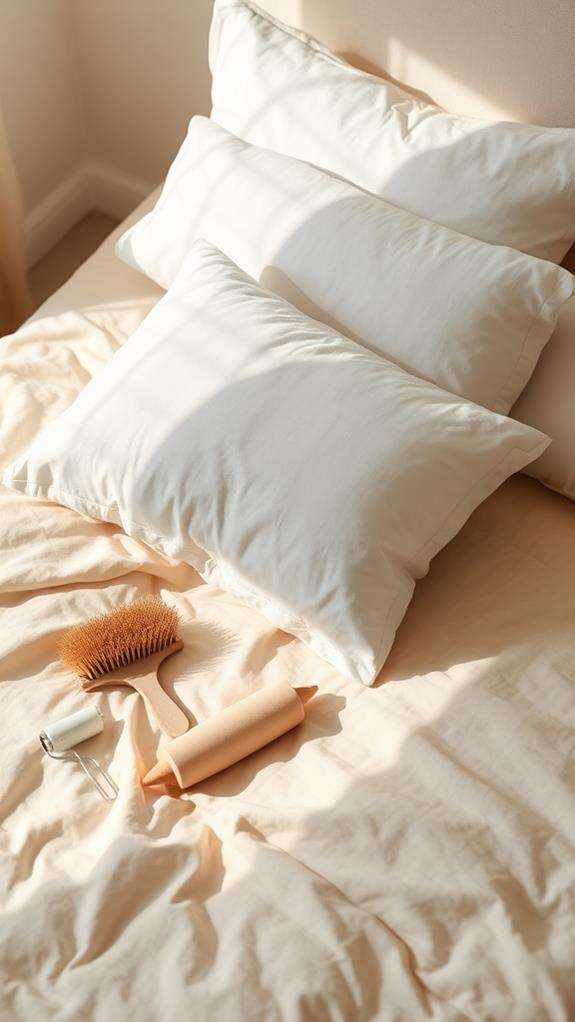
To keep your pillows in top condition, you'll need a combination of basic tools, including dryer balls or tennis balls for mechanical fluffing, and specialized equipment like handheld pillow fluffers for targeted maintenance. While natural tools like clean towels and sunlight can effectively support your pillow care routine, synthetic tools such as air pumps and vacuum attachments offer more intensive cleaning and revitalization options. Your essential pillow maintenance toolkit should also include proper pillow protectors, which serve as a fundamental defense against wear and tear while preserving the effectiveness of your other fluffing tools.
Essential Fluffing Equipment Needed
The right tools make all the difference when maintaining your pillow's ideal fluffiness and shape. When you're ready to revive your tired pillows, you'll need specific equipment designed for effective fluffing and maintenance. Your success depends on having the proper tools readily available, whether you're using traditional methods or modern alternatives.
Here's what you'll need in your pillow-fluffing arsenal:
- Clean tennis balls or dryer balls for mechanical agitation during the drying process, helping break up clumps and restore loft
- Breathable pillow protectors that safeguard your pillows while allowing proper air circulation and maintaining shape
- An upholstery attachment for your vacuum cleaner to remove dust and debris that can compress filling
- Clean cotton socks for the DIY sock method, which provides a gentler alternative to tennis balls
- Fresh towels to help absorb excess moisture during the drying process
You'll find that combining these tools with proper technique yields the best results. For instance, using tennis balls or dryer balls alongside pillow protectors creates a thorough softening method that maintains both cleanliness and fluffiness. Remember to always check your pillow's care label before implementing any fluffing technique.
Natural vs. Synthetic Tools
When choosing tools for pillow maintenance, understanding the differences between natural and synthetic options helps you make informed decisions about your fluffing routine. Your hands serve as the most basic natural tool, allowing you to redistribute fill material while maintaining complete control over the process. Meanwhile, synthetic tools like tennis balls provide consistent, mechanical action when you're fluffing a pillow in the dryer.
| Tool Type | Benefits | Best Used For |
|---|---|---|
| Natural (Hands) | Direct control, immediate feedback | Daily maintenance |
| Synthetic (Tennis Balls) | Consistent agitation, thorough fluffing | Dryer cycles |
| Specialized Equipment | Precise reshaping, professional results | Deep restoration |
You'll find that natural tools, including sunlight exposure, offer chemical-free solutions for maintaining your pillows. The sun's rays naturally sanitize while helping eliminate moisture. If you're looking for more specialized equipment, manual fluffing devices provide targeted solutions for stubborn cases. By combining both natural and synthetic tools in your maintenance routine, you'll achieve superior results. For instance, you might start with manual techniques for daily upkeep, then supplement with tennis balls during monthly dryer cycles for deeper restoration.
Specialized Pillow Care Devices
Professional pillow care devices step up your maintenance game with specialized features designed for perfect fluffing results. When you're looking to maintain loft and extend your pillow's lifespan, these tools offer efficient solutions that go beyond manual fluffing. Electrical pillow fluffers, for instance, use controlled airflow to penetrate the filling, rejuvenating the fill while promoting better fluffiness throughout.
To make the most of specialized pillow care devices, you'll want to follow the manufacturer's instructions carefully to protect your investment. A pillow-specific cleaning tool helps remove accumulated debris, while compression bags guarantee proper storage and travel protection.
Here's what you'll find in an extensive pillow care toolkit:
- Electric pillow fluffers with adjustable airflow settings for different fill types
- Specialized vacuum attachments designed specifically for pillow maintenance
- Compression storage bags with air-release valves for space-saving storage
- Pillow-specific cleaning tools with antimicrobial properties
- Professional-grade fluffing wands that help distribute fill evenly
These devices work together to create a complete pillow maintenance system, helping you maintain top-notch comfort and extend your pillow's durability through proper care and regular maintenance.
Daily Fluffing Routine
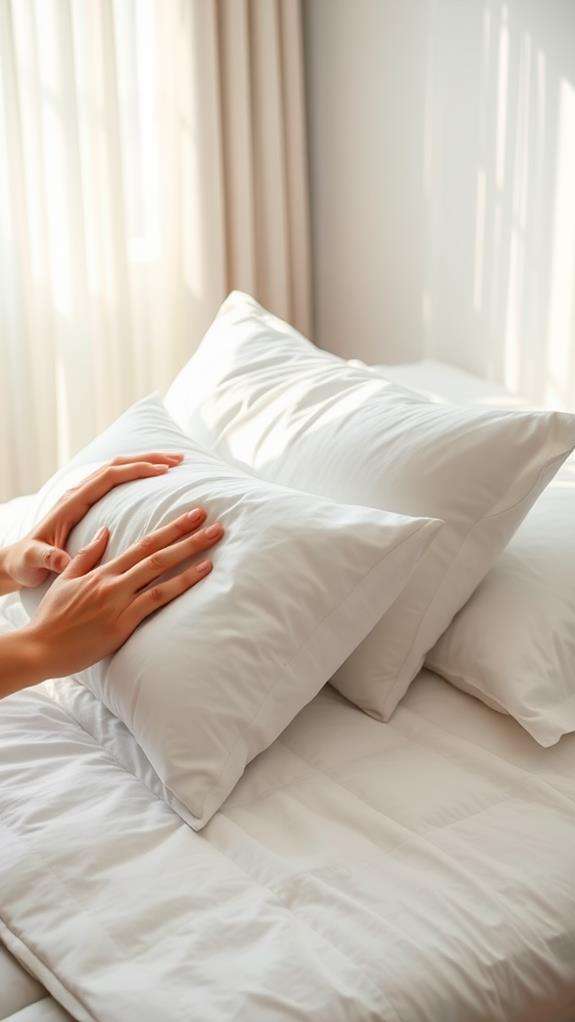
Maintaining your pillow's comfort and support requires just a few minutes of daily attention. Taking time to fluff your pillow each day will help maintain its loft and guarantee you'll have a better night's sleep on a consistently comfortable surface.
To establish an effective daily fluffing routine, start by setting aside 30 seconds each morning after you get out of bed. The most efficient method involves grasping opposite sides of the pillow and pushing them together, then releasing. You'll want to repeat this motion several times, rotating the pillow as you go. Next, try the accordion technique: compress the pillow's sides inward and outward repeatedly to introduce fresh air into the fill material.
Don't rush through the process—methodical fluffing yields the best results. Pay special attention to any flattened areas, and make sure you're working the fill evenly throughout the pillow's surface. You'll notice immediate improvements in your pillow's appearance and feel, but the real benefit comes from maintaining this routine consistently. Over time, you'll extend your pillow's lifespan while guaranteeing peak support for your neck and spine.
Seasonal Pillow Care Tips
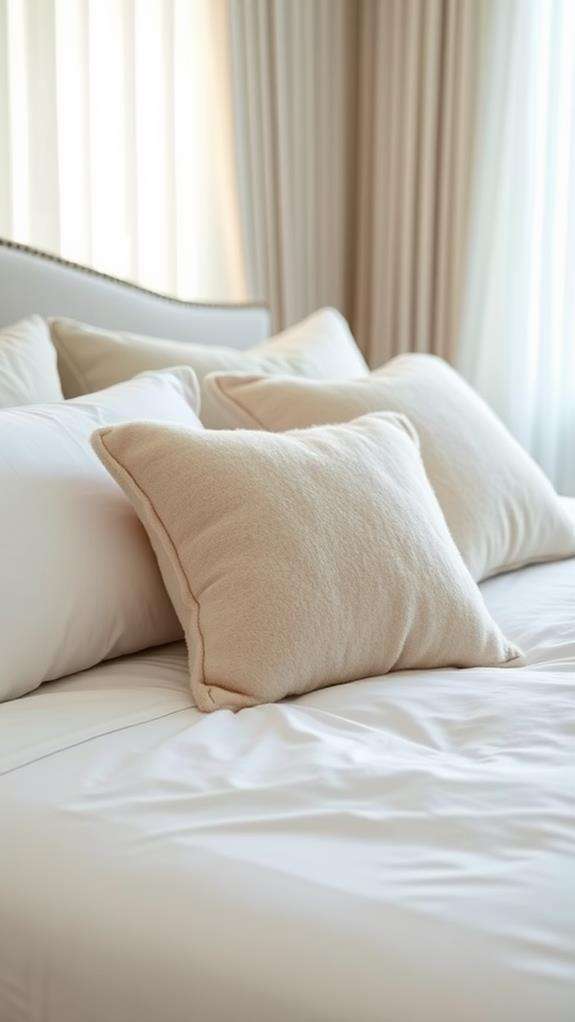
Changing seasons demand different approaches to pillow care if you want to maintain ideal comfort year-round. Your seasonal pillow care routine should adapt to temperature changes, humidity levels, and your evolving sleep position preferences throughout the year. To keep your pillows in prime condition, it's important to rotate seasonal pillow cases and implement specific care techniques for different weather conditions.
- Place pillows in direct sunlight during summer months, letting the sun and breeze naturally disinfect and refresh them
- Use breathable cotton storage bags during off-seasons to protect pillows from moisture and dust buildup
- Install pillow protectors during winter to guard against increased sweat and oil accumulation
- Monitor your sleep position changes across seasons, adjusting pillow fluffiness accordingly
- Evaluate pillow condition each season to determine if it's time to replace them
Remember to fluff your pillow more frequently during humid months, as moisture can cause filling to clump together. When storing off-season pillows, make sure the space is cool and dry to prevent mold growth. For winter pillows, consider using moisture-wicking protectors that can extend their lifespan while maintaining ideal support and comfort.
Expert Fluffing Techniques
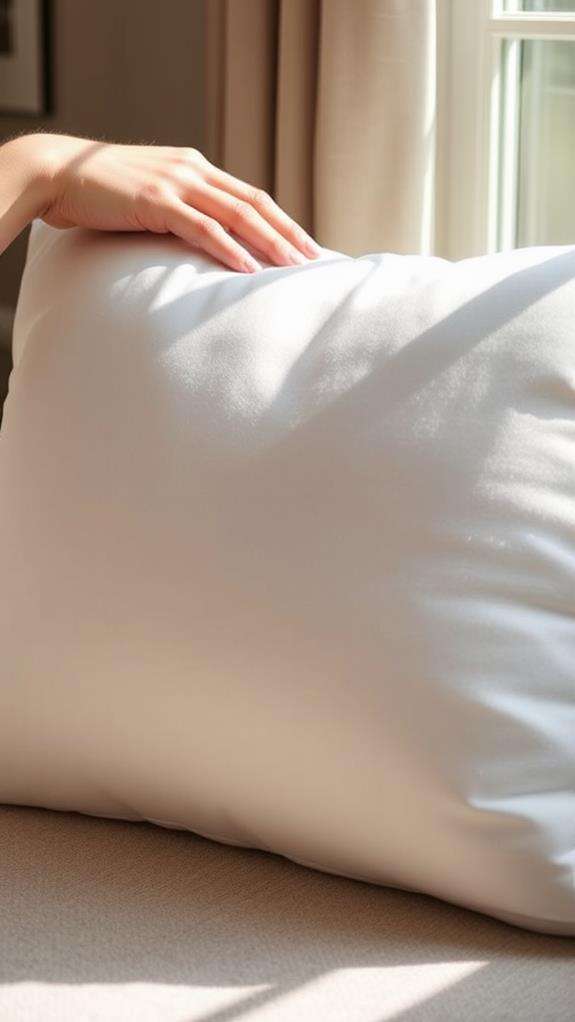
Mastery of proper fluffing techniques can transform a lifeless pillow into a cloud-like haven of comfort. To restore your pillow's ideal loft, you'll want to make use of several proven methods to redistribute the filling effectively.
Start with the accordion method, where you'll grab both ends of the pillow and compress it inward, then release repeatedly to keep the fill moving. Next, try gentle kneading motions across the entire surface, working systematically to break up any clumps. If your pillow needs extra care, toss it in the dryer on low heat with a tennis ball for 10-15 minutes – this method works particularly well to fluff down and synthetic fills.
For those seeking natural tips and tricks, sun exposure proves remarkably effective. Place your pillow in direct sunlight for 3-4 hours, which won't just restore its shape but will also eliminate unwanted moisture and bacteria. Remember that different materials require specific approaches – memory foam pillows respond best to low heat and manual shaping, while down alternatives benefit most from vigorous hand fluffing. By incorporating these expert techniques into your regular pillow maintenance routine, you'll extend your pillow's lifespan considerably.
Frequently Asked Questions
How Do I Get My Pillows Fluffy Again?
To restore your pillows' fluffiness, you've got several effective methods. Start by hand-fluffing for 30 seconds, clapping diagonal corners and massaging out lumps. You can also toss them in the dryer with tennis balls for 20 minutes on medium heat. For a natural approach, place pillows in direct sunlight for 3-4 hours. Remember to fluff daily to maintain shape, and if they won't revive, it's time for replacement.
How Do You Fluff a Puffy Pillow?
To fluff your puffy pillow, you'll want to start by giving it a vigorous shake while holding one end. You can also try clapping the pillow between your hands to help redistribute the fill. For stubborn flatness, knead and massage the pillow to break up any clumps. If you need extra help, toss it in the dryer on low heat with dryer balls for 10-20 minutes, or let it sunbathe outside for a few hours.
How Do I Refluff My Pillow?
Ever wonder why a flat pillow can ruin your sleep? You can easily refluff your pillow using several methods. Start by vigorously shaking and squeezing it from different angles, then massage any lumps to redistribute the filling. For machine fluffing, toss it in the dryer on low heat for 20 minutes with dryer balls. You can also place your pillow in direct sunlight for a few hours to freshen and naturally restore its loft.
Can You Fluff Pillows in the Dryer?
Yes, you can fluff pillows in the dryer using a low to medium heat setting. For best results, add a couple of dryer balls or a tennis ball in a sock to help redistribute the filling. Make certain your pillows are dryer-safe by checking the care label first. You'll want to run them for 10-20 minutes, and it's best to put two pillows in at opposite sides for balance. Just verify they're completely dry before starting.





